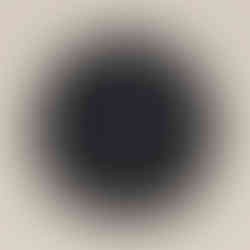拍賣筆記 vol.201 邦瀚斯倫敦:21760英鎊成交,金黑釉油滴盞20.88萬人民幣售出 - Emmanuel Christofides, Priestley & Ferraro, A Large Black-Glazed 'Oil-Spot' Bowl
- SACA

- May 15
- 3 min read
Updated: May 16

20.88萬人民幣的成交價,價格低窪,油滴品種實屬罕見,大德寺龍光院藏有一件較小的茶碗,紐約亞洲藝術協會洛克菲勒收藏有一件直沿洗。這類品種認知、共識還在逐漸形成。6087號牌。
帶有銀色圓斑的黑釉瓷器,如本品,即今所稱之「油滴釉」器物。此一術語「油滴釉」(you di you)並非古稱,而是20世紀自日本引入中國的現代用語。在日本,對於中國黑釉斑紋瓷器的賞識由來已久,早於15世紀上半葉便已有「油滴天目」(yuteki tenmoku)之稱,並見於文獻記載。
金 黑釉油滴盞
A LARGE BLACK-GLAZED 'OIL-SPOT' BOWL
Jin Dynasty
慧習相成:宋瓷人生
2025 年 5 月 15 日 10:00 BST
倫敦,新龐德街
£15,000 - £20,000
來源:
吳繼遠,香港,1998年
倫敦古董商Priestley & Ferraro Chinese Art
Emmanuel Christofides (1928-2020),雅典和倫敦,於1999年6月16日在"國際陶瓷博覽會暨研討會"從上處獲得,The Park Lane酒店,皮卡迪利
展覽著錄:
Priestley & Ferraro Chinese Art,《Catalogue》,倫敦,1998年,編號9
D.Priestley和M.Flacks,《A Life in the Company of Song Ceramics》,倫敦,2017年,第102-103頁,編號45(著錄插圖)

帶有銀色圓斑的黑釉瓷器,如本品,即今所稱之「油滴釉」器物。此一術語「油滴釉」(you di you)並非古稱,而是20世紀自日本引入中國的現代用語。在日本,對於中國黑釉斑紋瓷器的賞識由來已久,早於15世紀上半葉便已有「油滴天目」(yuteki tenmoku)之稱,並見於文獻記載。
惟回顧宋金時代,當時文人雅士與收藏家對於此類釉色並無明確命名或記錄,故其本稱已佚。學界推測,當時或曾以「鷓鴣斑」一詞泛指各類深色釉面上的自然斑斕現象,而不若今日僅限用以描述褐斑釉者。關於此一術語與釉色分類演變之討論,可參見R. D. Mowry 著作《兔毫、玳瑁與鷓鴣斑:公元400–1400年間的中國褐釉與黑釉瓷》(Hare’s Fur, Tortoiseshell, and Partridge Feathers: Chinese Brown and Black-Glazed Ceramics, 400–1400),劍橋麻州,1996年,第149頁。
關聯器物方面,可參見一件直徑相若(21公分)之油滴黑釉盞,宋代,現藏北京故宮博物院,著錄於《故宮博物院藏文物珍品大系:兩宋瓷器(上)》,香港,1996年,頁226,編號204。
另有二例市場紀錄可資參考:— 一件北宋/金代油滴黑釉小盞,售於佳士得香港,2017年4月4日,拍品編號26;— 另一件金代黑釉褐斑油滴盞,售於佳士得香港,2022年5月30日,拍品編號2840。

A LARGE BLACK-GLAZED 'OIL-SPOT' BOWL
Jin Dynasty
Provenance:
K.Y. Ng, Hong Kong, 1998
Priestley & Ferraro Chinese Art, London
Emmanuel Christofides (1928-2020), Athens and London, acquired from the above on 16 June 1999 at The International Ceramics Fair and Seminar, The Park Lane Hotel, Piccadilly, London

Published, Illustrated and Exhibited:
Priestley & Ferraro Chinese Art, Catalogue, London, 1998, no.9
D.Priestley and M.Flacks, A Life in the Company of Song Ceramics, London, 2017, pp.102-103, no.45 (published and illustrated)
Black-glazed ceramics with circular, silvery markings, such as the present lot, are now commonly referred to in Chinese as you di you ('oil-spot glazes'), a term introduced to China in the 20th century from Japan. In Japan, such Chinese glazes have long been highly esteemed and are known as yuteki temmoku ('oil-spot temmoku'), a name documented as early as the first half of the 15th century. The original term used for these glazes during the Song and Jin dynasties has been lost to history, as contemporary connoisseurs and collectors failed to record it in their writings. It is possible, though not certain, that in the Song dynasty, the term 'partridge feather' may have been applied to a broader range of dark glazes than the russet-splashed types it specifically describes today. For a discussion on this, see R.D.Mowry, Hare's Fur, Tortoiseshell, and Partridge Feathers: Chinese Brown and Black-Glazed Ceramics, 400-1400, Cambridge MA, 1996, p.149. See a related black-glazed bowl with oil-spots, Song dynasty, of similar diameter (21cm diam.), illustrated in The Complete Collection of Treasures of the Palace Museum: Porcelain of the Song Dynasty (I), Hong Kong, 1996, p.226, no.204.

See a related but smaller 'oil spot' black-glazed bowl, Northern Song/Jin dynasty, which was sold at Christie's Hong Kong, 4 April 2017, lot 26. Another black-glazed russet 'oil spot' bowl, Jin dynasty was sold at Christie's Hong Kong, 30 May 2022, lot 2840.







































Comments